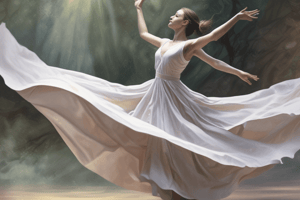Podcast
Questions and Answers
What is liturgical dance?
What is liturgical dance?
- A traditional folk dance
- A type of aerobic exercise
- A form of worship that combines movement and music (correct)
- A style of ballet
What does liturgical dance allow individuals to convey?
What does liturgical dance allow individuals to convey?
- Emotions, stories, and messages of faith (correct)
- Only stories
- Only physical strength
- Only emotions
What is one way liturgical dance enhances the worship experience?
What is one way liturgical dance enhances the worship experience?
- By visually representing the spiritual messages (correct)
- By excluding the congregation
- By ignoring the music
- By creating a loud atmosphere
What does liturgical dance provide?
What does liturgical dance provide?
What is a result of engaging in liturgical dance?
What is a result of engaging in liturgical dance?
What is a characteristic of liturgical dance?
What is a characteristic of liturgical dance?
What does liturgical dance enable individuals to experience?
What does liturgical dance enable individuals to experience?
What is true about liturgical dance?
What is true about liturgical dance?
What is the primary focus of liturgical dance?
What is the primary focus of liturgical dance?
What is one way liturgical dance fosters unity and community?
What is one way liturgical dance fosters unity and community?
What is one potential benefit of liturgical dance beyond worship services?
What is one potential benefit of liturgical dance beyond worship services?
In which ancient culture were temple dancers used to honor gods and goddesses?
In which ancient culture were temple dancers used to honor gods and goddesses?
When did the Catholic Church discourage dance as a form of worship?
When did the Catholic Church discourage dance as a form of worship?
What influenced the revival of liturgical dance in the 20th century?
What influenced the revival of liturgical dance in the 20th century?
What is a distinctive tradition of liturgical dance in African-American churches?
What is a distinctive tradition of liturgical dance in African-American churches?
What is the primary function of choreography in liturgical dance?
What is the primary function of choreography in liturgical dance?
What is one way liturgical dance enhances the worship experience?
What is one way liturgical dance enhances the worship experience?
What is one aspect of liturgical dance that promotes a sense of belonging?
What is one aspect of liturgical dance that promotes a sense of belonging?
What is one way that modern techniques can be used in liturgical dance?
What is one way that modern techniques can be used in liturgical dance?
What is a characteristic of African dance in liturgical dance?
What is a characteristic of African dance in liturgical dance?
What is the purpose of mime and gesture in liturgical dance?
What is the purpose of mime and gesture in liturgical dance?
What does sacred dance often incorporate?
What does sacred dance often incorporate?
What can be used to create a dynamic and meaningful performance in liturgical dance?
What can be used to create a dynamic and meaningful performance in liturgical dance?
What can be used to convey reverence, devotion, and worship in liturgical dance?
What can be used to convey reverence, devotion, and worship in liturgical dance?
What can be used to express joy and praise in liturgical dance?
What can be used to express joy and praise in liturgical dance?
Why is understanding different styles and techniques important in liturgical dance?
Why is understanding different styles and techniques important in liturgical dance?
What is the primary purpose of liturgical dance?
What is the primary purpose of liturgical dance?
What type of dance form is often used in Orthodox Christianity?
What type of dance form is often used in Orthodox Christianity?
What is the significance of liturgical dance garments?
What is the significance of liturgical dance garments?
What role does music play in liturgical dance?
What role does music play in liturgical dance?
What is the purpose of symbolic movements and gestures in liturgical dance?
What is the purpose of symbolic movements and gestures in liturgical dance?
How has liturgical dance evolved over time?
How has liturgical dance evolved over time?
What is the primary characteristic of contemporary dance?
What is the primary characteristic of contemporary dance?
What is a characteristic of ballet movements in liturgical dance?
What is a characteristic of ballet movements in liturgical dance?
What is the focus of modern dance in liturgical dance?
What is the focus of modern dance in liturgical dance?
What is the ultimate goal of liturgical dance?
What is the ultimate goal of liturgical dance?
Flashcards are hidden until you start studying
Study Notes
The Purpose and Significance of Liturgical Dance
- Liturgical dance is a form of worship that combines movement and music in a spiritual context, practiced for centuries to express devotion, celebration, and praise to a higher power.
- It serves as a powerful tool to communicate and express worship through physical movement, adding depth and meaning to the spiritual experience.
- Liturgical dance enhances the worship experience for both performers and the congregation, creating a sacred and enriching atmosphere.
- It provides a physical manifestation of one's faith, allowing individuals to experience their faith on a visceral level.
- Liturgical dance incorporates symbolism and spiritual interpretation into its movements, conveying a specific spiritual concept or emotion.
- It fosters unity and community building, promoting a sense of belonging and encouraging individuals to connect with others and build relationships within the faith community.
- Liturgical dance has the potential to facilitate healing and transformation on a personal level, allowing individuals to release emotional burdens, find solace, and experience spiritual renewal.
Exploring the History and Traditions of Liturgical Dance
- Liturgical dance has its roots in ancient religious practices and rituals, used as a form of worship to express devotion and reverence to the divine.
- In Christianity, liturgical dance can be traced back to the early church, with references to dancing during worship in the Psalms.
- The practice of liturgical dance experienced a revival in the 20th century as part of the liturgical movement, influenced by various artistic movements.
- Different religious denominations and cultures have developed their own distinctive traditions of liturgical dance, such as praise dance in African-American churches and Danza Azteca in Latin American Catholic traditions.
- Liturgical dance garments often reflect the sacred nature of the dance, with specific attire chosen depending on the tradition and theme being portrayed.
- Music plays a crucial role in liturgical dance, providing the rhythm and mood for the dancers, with hymns, psalms, and sacred songs often used.
Identifying Different Styles and Techniques Used in Liturgical Dance
- Contemporary dance is a style that combines elements of classical ballet, modern dance, and other styles to create a unique and expressive form of movement.
- Ballet is a classical dance form that can be incorporated into liturgical dance to create a sense of elegance and reverence.
- Modern dance emphasizes freedom of movement, expression, and individuality, and can be used to convey spirituality, express emotions, and explore the relationship between body and soul.
- African dance encompasses a wide range of traditional dances from various African cultures, characterized by energetic movements, polyrhythmic music, and strong connections to spirituality and community.
- Mime and gesture are powerful tools in liturgical dance that allow dancers to communicate and convey meaning without the use of words.
- Sacred dance is a term used to describe dance that is specifically dedicated to religious or spiritual themes, often incorporating movements and gestures that hold symbolic meaning.
Studying That Suits You
Use AI to generate personalized quizzes and flashcards to suit your learning preferences.





